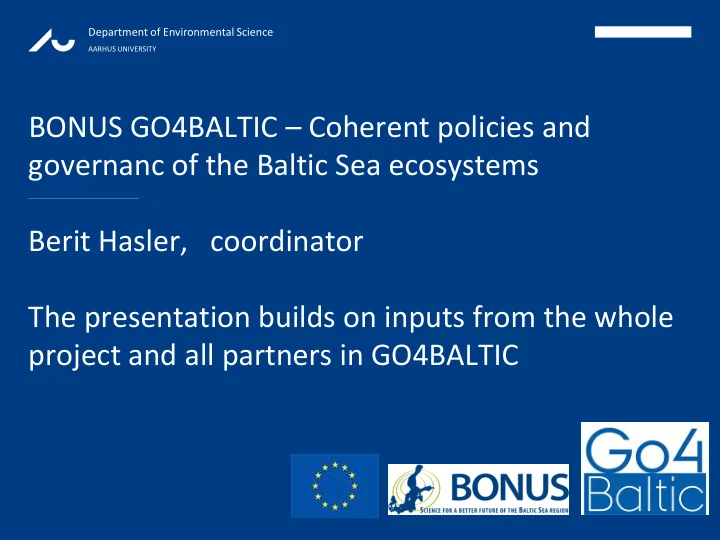

Department of Environmental Science AARHUS UNIVERSITY BONUS GO4BALTIC – Coherent policies and governanc of the Baltic Sea ecosystems Berit Hasler, coordinator The presentation builds on inputs from the whole project and all partners in GO4BALTIC
Department of Environmental Science AARHUS UNIVERSITY BONUS GO4BALTIC Examples of results and recommendations on Policies for cost-effecient nutrient abatement in the BS region Coherence and synergies with climate policies Five countries under study
Department of Environmental Science AARHUS UNIVERSITY 3 Incentives for 2 Innovation farmers’ GHG and technology and nutrient diffusion, reductions 4 Trade for 1 Cost-effective improved implementation allocation of N A Baltic Sea of BSAP and P Socio- economic Action Plan Recommendations for HELCOM
Department of Environmental Science AARHUS UNIVERSITY Cost-effective implementation Cost-effeciency: Allocate smallest amount of resources to the pollution To achieve least cost solutions abatement, to achieve the target the marginal costs equalised over (e.g. BSAP targets on nutrient load all abaters. reductions). When it is more costly for abater Many abaters, spread around the X than abater Y at the margin – it Baltic sea. How can the target be is effecient to move abatement shared? from X to Y until the marginal abatement cost is equal.
Department of Environmental Science AARHUS UNIVERSITY Results and recommendations #1 Fulfilling BSAP is costly for all countries around the Baltic. Climate mitigation is also costly, and agriculture contributes to both. All countries have signed up to international agreements (BSAP nutrient load reductions, climate mitigation): Combined N and P reductions reduce costs by 20% compared to individual implementation (Gren & Elofsson, 2017). Combined implementation of nutrient and climate policies reduces costs by 35% compared to individual implementation (Nainggolan et al 2018).
Department of Environmental Science AARHUS UNIVERSITY Innovation and technology Incentives to innovate, use novel technologies Swedish patent data over a 50-year period: increased regulation induced innovation in the wastewater treatment sector Short-run effect was estimated to 40-70% in the years after the introduction of new environmental regulations. A corresponding effect could not be identified in the agricultural sector. Difference in policy design: In the wastewater sector performance standards are used, setting limits on emissions. Agriulture: design standards, specific technologies required and subsidized.
Department of Environmental Science AARHUS UNIVERSITY Results and recommendations #2 Farm survey data from GO4BALTIC on farmers adoption of technologies – reasons for investments analysed. Expansion main reason; regulation and subsidy to a less extent. We suggest use of emission performance standards for larger farms in order to encourage innovative activity. Replace current EU and national regulations for agri-environmental measures, by performance standards that allows farmers to apply novel technologies.
Department of Environmental Science AARHUS UNIVERSITY Incentives for farmers, AES Survey of 2439 farmers in 2017, Contracts Farm Five countries. Incentives to adopt survey Agri-environmental schemes analysed. Relevance: CAP post 2020 Share of utilised agricultural area covered with AES, statistical data
Department of Environmental Science AARHUS UNIVERSITY Results and recommendations #3 Minimum willingness to accept (WTA) levels for adoption of AES. These results vary substantially between countries. Farmers prefer shorter contracts and contracts that require enrolling lower areas of land. Farm type, farm size, country of origin have effects as well. Differentiated contracts will have a higher probability of participation than uniform payment schemes. Results supports the ongoing CAP 2020 revision.
Department of Environmental Science AARHUS UNIVERSITY Trading water quality and/or nutrients › Large heterogeneities in costs of abatement across polluters: opportunities for implementing economic instruments for water quality management. › Examples: Trade of manure, trading water quality requirements. › Water quality trading scheme: cost-effective policy mechanism with reliable target achievement. › Few schemes have been implemented in practice and even fewer successes have been reported.
Department of Environmental Science AARHUS UNIVERSITY Results and recommendations#4 Cost-effective, but heterogeneity between farmers /abaters necessary for trade Farm characteristics influence the decision on supply/purchase of nitrogen abatement, as well as the amounts being traded. Farmers trade, but there are barriers. Might be uncertainty. Citizens and experts prefer direct regulation and agri-environmental subsidies to nutrient trading. For experts’, nutrient trading is unlikely to deliver sufficiently large cost savings to be preferred to other instrument types. This potentially explains the low take-up of water quality trading schemes outside the United States. Still interesting from economic point of view!
Department of Environmental Science AARHUS UNIVERSITY Differentiate subsidies Target incentives, performance based 3 Incentives for 2 Innovation farmers’ GHG and technology and nutrient Difficult, but aims diffusion, reductions Reduce to distribute eutrophication, manure better climate change Less costs 4 Trade for improved allocation of N 1 Cost-effective A Baltic Sea and P implementation Socio- of BSAP economic Action Plan Recommendations for HELCOM, CAP post 2020, countries
Department of Environmental Science AARHUS UNIVERSITY Acknowledgements › The work presented is part of the BONUS GO4BALTIC project: http://projects.au.dk/go4baltic/ › The BONUS GO4BALTIC project is supported by BONUS (Art 185), funded jointly by the EU and national funding institutions in Denmark (the Innovation Fund), Estonia (Estonian Research Council ETAG ), Finland (Academy of Finland), Poland (NCBR) and Sweden (FORMAS).
Recommend
More recommend